Africa’s quest for continental peace and security exists at a time when armed violence and conflict continue to ravage the continent. The African Union (AU) has embarked on a continent-wide campaign focused on reducing armed violence by tackling uncontrolled and illicit arms. Dubbed Silencing the Guns in Africa by 2020, the campaign is part of AU’s Agenda 2063 – a strategic framework for inclusive and sustainable growth and development pursued in the spirit of Pan-Africanism and African Renaissance. To realize its vision of a continent free of violent conflicts, the AU, together with other stakeholders, should prioritize actions that will mobilize Africa’s youth, and engage them effectively and meaningfully.
A Common Insidious Challenge
Africa’s struggle with uncontrolled proliferation and use of illicit arms has persisted for more than three decades and attempts to address it has had mixed results. In conflicts that reigned in the late 1980s and early 1990s, for instance, in Namibia, Angola, Sierra Leone, Liberia, and Cote d’Ivoire, guns have been silenced. In other cases, such as in South Sudan and Somalia, significant progress has been made toward stabilization of political institutions, thanks to robust peacebuilding and reconstruction efforts from regional and international partners. Furthermore, in some other places, conflicts persist, and violence seems to intensify. Countries like, South Sudan, DRC, CAR, Nigeria, Chad, Niger, Burkina Faso, Mali, Libya, and Cameroon are still convulsed with violent conflicts characterized by a constellation of arms and various kinds of ammunitions involving both state and non-state actors.
A 2017 study entitled, The Human Cost of Uncontrolled Arms in Africa, conducted by Oxfam estimated that about 100 million uncontrolled and illicit arms are in circulation in Africa. These arms are heavily concentrated in conflict hotspots and security-challenged countries. The reality of illicit arms presents two critical challenges to the maintenance of continental peace and security. First, although arms do not directly cause conflicts, their easy acquisition and use in crisis zones often empower armed groups (militias, political rebels, vigilantes and gangs) to engage in retaliatory battles against opposing factions, including governments and civilian communities, often with the result of escalating violence. Secondly, with porous borders, characterized by weak border-controls and less effective surveillance systems, guns and other military hardware are frequently and easily smuggled across state borders in Africa, thereby further complicating the human and economic costs of wars. For instance, in South Sudan, the ongoing conflict has been fuelled mainly by constant inflow and uncontrolled circulation of small arms and light weapons (SALWs) from neighboring countries, mostly Uganda and Eritrea and partly from the Middle East.
Notably, the problem of uncontrolled arms in Africa is majorly attributable to massive international transfers of weapons and sub-regional recycling across state borders that go against established regulatory measures such as the Arms Trade Treaty (ATT), existing moratoriums, and domestic policies. For instance, critical concerns exist over the implementation of the ATT. Until the close of December 2019, out of the 40 African States that had accented to the Treaty, only 26 had become full parties to it. Other States, 14 in number, have not signed the treaty. As an established global norm for regulating the sale and transfer of arms, the ATT is a vital tool for combating the proliferation of illicit arms, especially in Africa where the impact has been the greatest. However, laxities in the domestication and implementation of the treaty opens several loopholes that negatively expose the continent to the problem of illicit arms.
Necessity of Youth-Responsive Interventions
As several studies have concluded, Africa’s youth partly, yet significantly, contributes to the illicit arms problem as they are often involved in violent activities in which arms and other dangerous weapons are used. Through manipulation, incitement and exploitation, young persons have been used both by state and non-state actors to perpetrate armed violence in many conflict-ridden countries.
In other cases, politicians and rebel groups have recruited young people – supplying them with arms and other dangerous weapons, and placing them in the frontlines of battles – thus exposing them to violence at tender ages and entrenching a culture of violence and conflict. With high rates of unemployment, poor governance, and extreme exclusion and marginalization, in many conflicted countries, young people are easily enticed to join armed rebel and militia groups with prospects of getting financial benefits and/or a sense of social belonging. A case in point is South Sudan where youths have been involved in armed combat from both ends of the divide. There are also numerous incidents of ‘rented’ armed violence involving various youth organizations such the Gilweng, the White Army, Gojam Arm Group, the Arrow Boys, among others. In addition, both South Sudanese military and armed opposition forces have been variously accused of recruiting children and forcing them into conflict as child soldiers.
Towards Peace
The foregoing illustrations indicate that young people are actively involved in and affected by the arms problem in Africa. It is imperative, therefore, that approaches aimed at addressing these challenges focus on mobilizing the youth to embrace a culture of peace.
Such initiatives may include putting the youth at the forefront of non-militarized, prevention-oriented programs aimed at discouraging the ownership and use of illicit arms. A good entry point would be the activation of youth-sensitive disarmament, demobilization and reintegration (DDR) approach to encourage young people to refrain from illegally acquiring and using arms, and instead surrender them to responsible authorities. This can be done by initiating ‘soft power’ measures to ensure that non-material factors influencing possession and use of arms are effectively addressed.
Most importantly, the AU, and all other stakeholders including individual States, must take up measures that will provide alternative avenues through which the youth can thrive and grow. As inscribed in the Agenda 2063, these measures should focus on offering basic education, support skills acquisition, create employment and enable equal opportunities for the youth, as well as mainstreaming youth affairs in all relevant spheres.
Finally, African States should to scale-up their legislative and legal frameworks that tackle the illicit transfer and use of arms. Ascension to and domestication of the Arms Trade Treaty will help block the uncontrolled inflow and diversion of arms that are later on used in illicit activities across Africa.
Otieno O. Joel is a Research Assistant at the HORN Institute.
Photo: Firearms being burned in an undisclosed location in Africa. ‘Silencing the Guns in Africa by 2020’ as one of the flagship projects of Agenda 2063 (Photo Credit: Daily Maverick)



